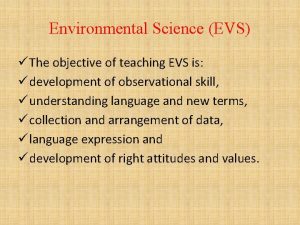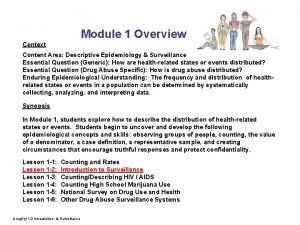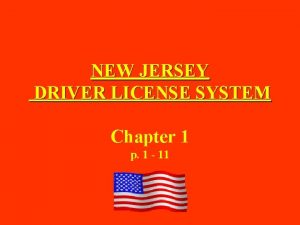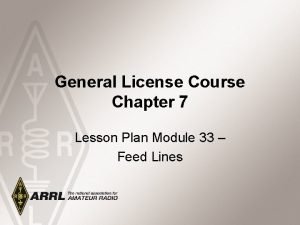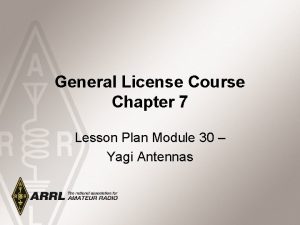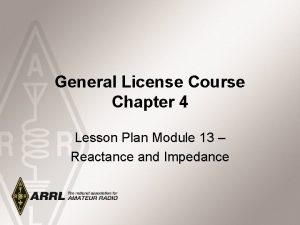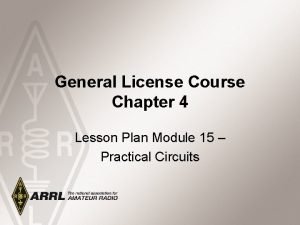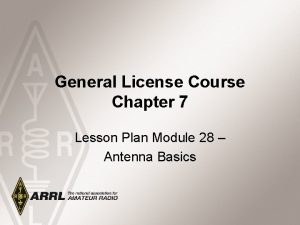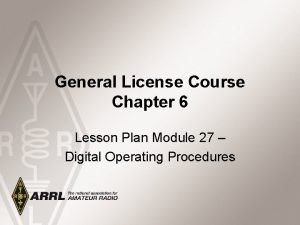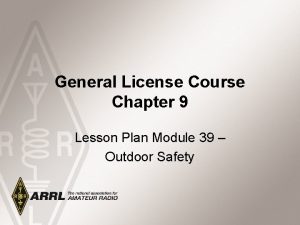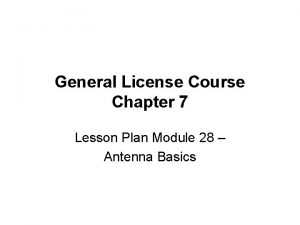General License Course Chapter 6 Lesson Plan Module











- Slides: 11

General License Course Chapter 6 Lesson Plan Module 23 – Digital Basics

Definitions • Bit – fundamental unit of data; 0 or 1 • Bit rate – number of digital bits per second sent from one computing system to the other • Symbol – a characteristic of the transmitted signal that represents data • Baud or bauds – number of symbols sent per second (symbol rate) 2015 General License Course 2

Definitions • Duty cycle – the ratio of time that the transmitter is on to the total of on time plus off time • Protocol – rules that control the method used to exchange data • Mode – the combination of a protocol with a modulation method such as RTTY or PSK 31 2015 General License Course 3

Protocol and Modulation • Protocol – the set of rules that control the encoding, packaging, exchanging, and decoding of digital data • Specifies how each packet is constructed and exchanged, what characters are used • How errors are detected and managed • Method of modulation chosen by convention • SSB or FM for packet radio, FSK or AFSK for RTTY 2015 General License Course 4

Frequency Shift Keying (FSK) • RTTY signal – two different tones shifting from one frequency to another • The rapidly changing tones are called mark and space • Space represents 0 • Mark represents 1 2015 General License Course 5

FSK – AFSK • FSK – the frequency of the transmitter’s VFO is controlled directly by a digital data signal from the computer • Audio frequency shift keying (AFSK) – audio tones are used to modulate an SSB or FM transmitter through the microphone input • Audio must be kept free of noise • ALC and compression must not be used to prevent distortion 2015 General License Course 6

Practice Questions 2015 General License Course

How is an FSK signal generated? A. By keying an FM transmitter with a sub-audible tone B. By changing an oscillator’s frequency directly with a digital control signal C. By using a transceiver’s computer data interface protocol to change frequencies D. By reconfiguring the CW keying input to act as a tone generator G 8 A 01 2015 General License Course

How is an FSK signal generated? A. By keying an FM transmitter with a sub-audible tone B. By changing an oscillator’s frequency directly with a digital control signal C. By using a transceiver’s computer data interface protocol to change frequencies D. By reconfiguring the CW keying input to act as a tone generator G 8 A 01 2015 General License Course

How are the two separate frequencies of a Frequency Shift Keyed (FSK) signal identified? A. Dot and Dash B. On and Off C. High and Low D. Mark and Space G 8 C 11 2015 General License Course

How are the two separate frequencies of a Frequency Shift Keyed (FSK) signal identified? A. Dot and Dash B. On and Off C. High and Low D. Mark and Space G 8 C 11 2015 General License Course
 Micro planners of assessment
Micro planners of assessment What are the objectives of evs
What are the objectives of evs C device module module 1
C device module module 1 Safety leadership for supervisors
Safety leadership for supervisors Course module sample
Course module sample Ravi poured the milk for the kitchen
Ravi poured the milk for the kitchen Flemish bond t junction
Flemish bond t junction Course title and course number
Course title and course number Chaine parallèle muscle
Chaine parallèle muscle Adjutant general captains career course
Adjutant general captains career course What is different about the ddl of drivers under age 21?
What is different about the ddl of drivers under age 21? Chapter 1 the new jersey driver license system answers
Chapter 1 the new jersey driver license system answers

